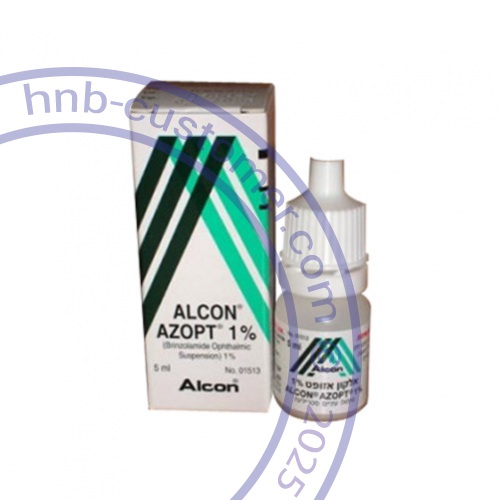Brinzolamide drops
What is this medicine?
BRINZOLAMIDE reduces the amount of fluid in the eye, which decreases pressure inside the eye. Brinzolamide ophthalmic (for the eyes) is used to treat certain types of glaucoma and other causes of high pressure inside the eye. Brinzolamide ophthalmic may also be used for other purposes not listed in this medication guide.
What should my health care professional know before I take this medicine?
You should not use this medication if you are allergic to brinzolamide. Before using this medication, tell your doctor if you are allergic to any drugs, or if you have narrow-angle glaucoma. FDA pregnancy category C. This medication may be harmful to an unborn baby. Tell your doctor if you are pregnant or plan to become pregnant during treatment.
It is not known whether brinzolamide ophthalmic passes into breast milk or if it could harm a nursing baby. Do not use this medication without telling your doctor if you are breast-feeding a baby.
How should I take this medicine?
Do not use this medication while you are wearing contact lenses. This medication may contain a preservative that can be absorbed by soft contact lenses. Wait at least 15 minutes after using the eye drops before putting your contact lenses in.
Use brinzolamide ophthalmic exactly as it was prescribed for you. Do not use the medication in larger amounts, or use it for longer than recommended by your doctor. Follow the instructions on your prescription label.
Wash your hands before using the eye drops.
To apply the eye drops:
- Tilt your head back slightly and pull down on the lower eyelid to create a small pocket. Hold the dropper above the eye with the dropper tip down. Look up and away from the dropper. Squeeze out a drop and close your eye. Gently press your finger to the inside corner of the eye (near the nose) for about 1 minute to keep the liquid from draining into your tear duct.
- If you use the drops in both eyes, repeat the steps above in your other eye. Also wait at least 10 minutes before using any other eye drops that your doctor has prescribed.
Do not allow the dropper to touch any surface, including the eyes or hands. If the dropper becomes contaminated it could cause an infection in your eye, which can lead to vision loss or serious damage to the eye.
Do not use this medicine if it has changed colors or has particles in it.
Tell your doctor right away if you have an eye infection, injury, or plan to have any type of eye surgery. You may need to stop using the medicine for a short time.
What if I miss a dose?
Use the missed dose as soon as you remember. Skip the missed dose if it is almost time for your next scheduled dose. Do not use extra medicine to make up the missed dose.
What may interact with this medicine?
Before using brinzolamide ophthalmic, tell your doctor if you are using any of the following drugs:
-
salicylates such as aspirin, Novasal, Doan's Extra Strength, Salflex, Tricosal, and others;
This list is not complete and there may be other drugs that can interact with brinzolamide ophthalmic. Tell your doctor about all the prescription and over-the-counter medications you use. This includes vitamins, minerals, herbal products, and drugs prescribed by other doctors. Do not start using a new medication without telling your doctor.
What should I watch for while using this medicine?
Do not use this medication while you are wearing contact lenses. This medication may contain a preservative that can be absorbed by soft contact lenses. Wait at least 15 minutes after using the eye drops before putting your contact lenses in. Before using this medication, tell your doctor if you are allergic to any drugs, or if you have narrow-angle glaucoma.
Do not allow the dropper to touch any surface, including the eyes or hands. If the dropper becomes contaminated it could cause an infection in your eye, which can lead to vision loss or serious damage to the eye. Do not use any other eye medication unless your doctor has prescribed it for you. If you use another eye medication, use it at least 10 minutes before or after using brinzolamide ophthalmic. Do not use the medications at the same time.
Brinzolamide ophthalmic can cause blurred vision. Be careful if you drive or do anything that requires you to be able to see clearly.
What side effects may I notice from this medicine?
Get emergency medical help if you have any of these signs of an allergic reaction: hives; difficulty breathing; swelling of your face, lips, tongue, or throat.
Stop using this medication and call your doctor at once if you have any of these serious side effects:
-
swelling or redness of your eyelids;
-
eye redness, discomfort, or sensitivity to light;
-
drainage, crusting, or oozing of your eyes or eyelids;
-
fever, sore throat, and headache with a severe blistering, peeling, and red skin rash;
-
pain in your upper stomach, jaundice (yellowing of your skin or eyes);
-
pale skin, easy bruising or bleeding; or
-
chest pain.
Less serious side effects may include:
-
blurred vision, double vision, drooping eyelid;
-
burning or stinging in your eye;
-
bitter or unusual taste in your mouth;
-
stomach or back pain;
-
dry eyes, feeling that something is in your eye;
-
headache; or
-
nausea, diarrhea.
This is not a complete list of side effects and others may occur.
Where can I keep my medicine?
Store this medication at room temperature away from moisture and heat. Keep the bottle tightly closed when not in use.





